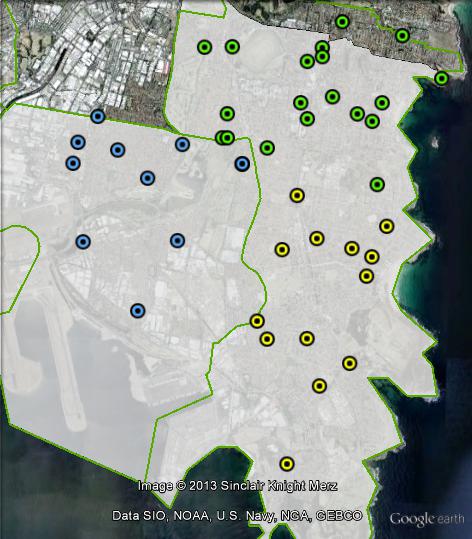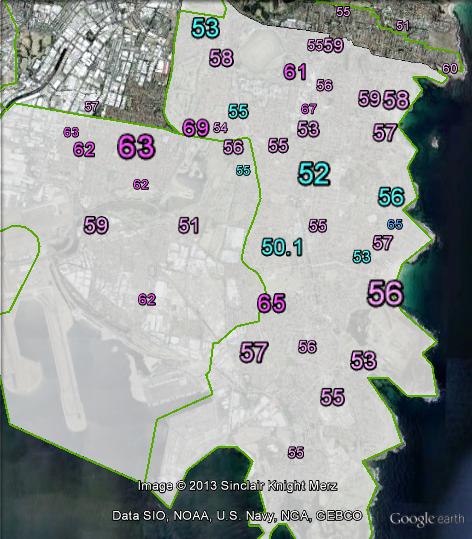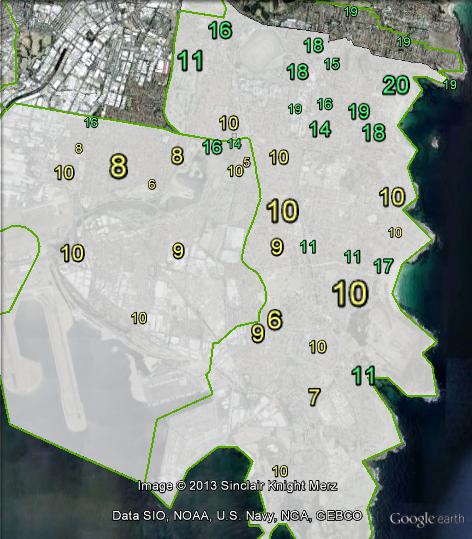ALP 5.2%
Incumbent MP
Peter Garrett, since 2004.
Geography
South-eastern Sydney. Kingsford Smith covers southern parts of the Eastern Suburbs of Sydney, including all of Botany Council and most of Randwick Council. Kingsford Smith includes the suburbs of Coogee, Randwick, Maroubra, Mascot, Malabar and Kensington.
History
Kingsford Smith was first created for the 1949 election after the House of Representatives was expanded. The seat has always been held by the ALP, originally being a marginal seat in its early years before gradually becoming safer, and it has been solidly safe since at least the 1960s.
Gordon Anderson (ALP) won the seat in 1949 with a bare 50.9% margin over the Liberal Party, and only won a 50.5% margin upon reelection in 1951. Anderson won with 54.2% in 1954, before retiring in 1955.
The seat was won in 1955 by Daniel Curtin (ALP), who had previously held the seat of Watson since 1949. Curtin won in 1955 with 55% of the vote, and the seat’s has only dipped below 5% once since 1955, in the 1966 landslide.
Curtin held the seat until 1969, and in that time solidified the ALP’s hold on the seat, but was almost defeated at his last election in 1966.
Curtin retired in 1969 and was succeeded by the state member for Randwick, Lionel Bowen, who won the seat with a margin over 10% for the first time. Bowen was a minister in the Whitlam government and became a senior member of the ALP in opposition in the late 1970s.
Bowen served as Deputy Prime Minister for the first three terms of the Hawke government, from 1983 until his retirement at the 1990 election.
He was succeeded in 1990 by Laurie Brereton. Brereton had briefly succeeded Bowen as member for Randwick from 1970 until the seat was abolished in 1971, when he moved to the seat of Heffron. Brereton served as a minister in the Wran and Unsworth governments before switching to the federal arena in 1990, after the Liberals won a landslide victory in New South Wales.
Brereton served as a federal minister in the final term of the Keating government and served as Shadow Minister for Foreign Affairs from 1996 until 2001, when he moved to the backbench.
In 2004 Brereton retired and was succeeded by Peter Garrett, former lead singer of Midnight Oil and President of the Australian Conservation Foundation. Garrett had also previously run for the Nuclear Disarmament Party in the Senate at the 1984 election, losing due to the Labor and Liberal parties preferencing each other over the NDP.
Garrett joined the ALP frontbench upon the election of Kevin Rudd as Labor leader in late 2006. Garrett served as Environment Minister in the first term of the Labor government, and as Minister for School Education since the 2010 election.
Candidates
Sitting Labor MP Peter Garrett is not running for re-election.
- Jacquie Shiha (Christian Democratic Party)
- Danielle Somerfield (Rise Up Australia)
- Matt Thistlethwaite (Labor)
- Michael Feneley (Liberal)
- Geordie Lucas (Future Party)
- James Macdonald (Greens)
Assessment
Kingsford Smith is held by Peter Garrett by a vulnerable 5.2%, and could be in danger in 2013. However the eastern suburbs of Sydney are not known for large swings, and this seat could remain in Labor hands while seats with larger margins fall.
2010 result
| Candidate | Party | Votes | % | Swing |
| Peter Garrett | ALP | 35,957 | 43.83 | -8.93 |
| Michael Feneley | LIB | 33,836 | 41.25 | +7.31 |
| Lindsay Shurey | GRN | 9,885 | 12.05 | +1.63 |
| Josh Carmont | DEM | 1,047 | 1.28 | +1.28 |
| John Cunningham | ON | 728 | 0.89 | +0.89 |
| Zac Hambides | SEP | 576 | 0.70 | -0.56 |
2010 two-candidate-preferred result
| Candidate | Party | Votes | % | Swing |
| Peter Garrett | ALP | 45,249 | 55.16 | -8.10 |
| Michael Feneley | LIB | 36,780 | 44.84 | +8.10 |

Booth breakdown
Booths have been divided into three areas. Booths in the City of Botany Bay have been grouped together. Booths in the City of Randwick have been split between Coogee in the north and Maroubra in the south.
The ALP’s margin varied from 60.2% in Botany to 53.7% in Maroubra. The Greens vote varied from 15.4% in Coogee to 8.8% in Botany.
| Voter group | GRN % | ALP 2PP % | Total votes | % of votes |
| Coogee | 15.46 | 54.61 | 25,146 | 30.66 |
| Maroubra | 9.80 | 53.70 | 22,385 | 27.29 |
| Botany | 8.82 | 60.18 | 14,313 | 17.45 |
| Other votes | 12.58 | 53.92 | 20,185 | 24.61 |




A mix of a few things. Older residents from when Maroubra/South Coogee was working class, inner-city lefties and general progressives, families, students, plus some public housing.
KS isn’t as wealthy as Wentworth, but wealthy people don’t inherently vote Liberal. Look at Sydney and Grayndler, where a lot of wealthy progressives live. I think that KS is moving from working class to a mix of tory/blue-blood wealthy and progressive/inner-city wealthy. As I said before, whether this is moving from Labor to Liberal or just Labor to new Labor, I’m not sure.Matt is a good candidate though.
Given that there was a bit of discussion around the robopolls, I’m going to repeat my suggestion I’ve made before about why certain patterns have been seen both at the last election and this one.
I’d assert that robopolls overestimate the vote for the party that has more solid support. This is because robopolls don’t typically allow for “undecided” – people who are genuinely undecided between two parties aren’t going to want to answer a poll that asks who you’re going to vote for. This influences the non-response numbers. And all of these polling companies basically remove the non-response figures when reporting the results. It’s also a lot easier for a person to choose to hang up on an automated message than on a person.
In 2010, most people made up their mind pretty quickly on Gillard (who had been DPM for nearly three years), but Abbott was an untested leader who people were still just getting to know. The result was robopolls, especially, understating Coalition support and overstating Labor support. At this election, it has been the other way around, because while Abbott has become a well-known figure, Rudd’s return has people uncertain about Labor – especially because they like Rudd but don’t like Labor.
Also note that such polls have routinely underestimated Greens and minor party support, which also makes sense – voters who are undecided are often undecided because they don’t know whether or not to vote for the major party, especially when you have the asymmetric circumstances as happened in 2010 and is happening now.
Other polls will generally not have as significant a bias due to this effect, as people are less likely to hang up on a person, and the operator is able to encourage an answer. And the ones (specifically, non-robopoll) that actually include “undecided” amongst their options make the effect more obvious; the “undecided” numbers themselves are particularly high. This is, unsurprisingly, most present in marginal seats, where more is seen to be at stake based on their vote – this is why it’s the marginal seats that are showing the biggest swings by far, counter to expectations (national polls are saying an average 2PP swing of 2-4%, whereas the average swing in marginal seats appears to be 7%).
A similar effect would also be expected in seats like this, where the incumbent has retired, and thus people are more likely to re-evaluate their support for the incumbent party.
Glen, thanks for the thoughful and considered post. I don’t know if I agree with it or not, but it does have me thinking. I certainly will be thinking about it on election night. Cheers.
Great post Glen. I don’t know enough about polling to make an educated judgement, but certainly some food for thought. Helps to explain some of the trends I’m seeing.
Glen, your entire argument rests on the premise that robolls, plural, overstate the leading party’s vote and understate the Greens vote. I think that needs some proof, so the first question is what polls are we talking about and what are we comparing them to? As best I can tell, ReachTEL didn’t do nationwide polling last time, AMR didn’t either, and Lonergan didn’t exist. If we are simply talking about a comparison of the current results in robopolls to other polls, then talking about “understating” the Greens vote is probably wrong. In general, the traditional pollsters overstate the Greens when their polling is compared to the election result, so robopollsters showing a reduced vote for them may be a sign of accuracy.
I’m also not sure about your point that smaller parties get a late surge because voters who are undecided because they are unmoved by the major parties end up deciding at the end to go for a minor party. Either the minor party support is even more overstated than we think, but it is disguised by the late swing, or undecideds swing much more evenly among the party groups, though more to the majors.
There are two areas I agree with you. Well, one where I agree with you and one where you may agree with me. I agree with you about undecided voters more generally. It is a problem that robopolls don’t allow for them, and the only reason I can think of for why they don’t report them is that robopolls can’t get leaners to report their lean. That would lead to excessive undecided rates that would make the polls useless. But I would go further. I’m not comfortable with the traditional pollsters who don’t report undecideds alongside the parties. There really should be five groups reported (Labor, Coalition, Greens, Other, and Undecided) rather than four.
The area where I might find you agree with me is on Lonergan. Way back in the Day Eight post, DB and I were discussing the seemingly sudden shift to the Coalition, and one problem I had with the Lonergan poll is that they report their responses from people about whom they voted for at the last election were in line with the last election result. The problem is that voters tend to report having voted for the winner at greater rates than the party’s actual share. So if Lonergan’s respondents are reporting Labor’s share where it actually was at the last election, that would suggest Labor is being undersampled or underweighted. I’m not sure how far that goes, though. When you have three robopolls in a single seat, Lonergan seems to have the Coalition’s primary a few points ahead of where the other robopolls are. I’m not sure if the undersampling would only account for some of that or all of that, or if it accounts for a lot more. But basically, I was very suspicious of Lonergan from the start, and the Griffith poll showing Rudd behind has convinced me to just ignore them until the election proves them wrong or right.
see my comment on QLD Senate just posted. Kevin Bonham’s view reposted.
RichR – I’m not so much claiming that robopolls are unique in the effect, but that they make it bigger because they typically don’t even give the opportunity to choose “undecided” and it’s easier to hang up on an automated pollster.
As for the question of robopolls at the 2010 election, the main one was the JWS robopoll, from three days before the election, that had Labor at 51.6% 2PP and predicted that Labor would win 79 seats. It had a sample size of a massive 28,000, which should produce a MoE of less than 0.6%. It had Labor picking up (with 54% 2PP) the seat of Cowper (actually 59.23% to Nationals in 2PP). It also only predicted three independents (I believe neither Wilkie nor Bandt were correctly predicted).
SMH “Team Rudd is in Sydney where it is headed for a childcare centre in the seat of Kingsford Smith before another Sydney later this morning”. That suggests internal Labor polling puts this in trouble as per the Robopolls.
Glen, in totality, the Robopolls were a pretty good indicator at the last Federal election in most cases (as you say 79 for Labor when they got 73) except for a few exceptions, generally in regional seats where there is considerable demographic/cultural differences. We won’t know until election night whether they were on the mark, however, I will say, internal polling is somewhat between those results and the national polling. In any case, except for QLD, the Robopolls are pretty much in line with the national polls (particularly TAS and NSW). It’s only QLD where there is a big difference and perhaps that can be somewhat put down to the sophomore surge effect as Peter Brent refers to in his article today on Mumble.
So what exactly is your internal polling saying, DB….something like 54-46??
Internal polling places the Coalition ahead of Labor in a tight race.
Kevin’s gone crazy and is getting rid of all the ALP’s furniture! Even heartland seats up for grabs, make us an offer!
Yere its almost getting back to what it was in April/May Propmike. The ALP made the fatal mistake of hoping Abbott would fall over but he just keeps on going…….. I might even see if I can back him in the Melkbourne Cup this year he’s such a good stayer……….Not bad for someone who was unelectable…….
Will be interesting to see if the fake Council letter will de-rail Mr. Thistlethwaite’s chances!
Would be interesting to see if Garrett had more personal votes then other members and whether this seat will swing more then others
I think that most commentators would agree the proposition that Garrett had a higher incumbent vote than the average.
Yappo – I’d agree with that proposition which makes this seat line ball I think.
SMH seat profile on the closeness of the race, http://www.smh.com.au/federal-politics/federal-election-2013/labor-battles-swing-to-retain-south-sydney-heartland-20130905-2t6x3.html
Matt Thistlethwaite pulled off one hell of a win. Less than a 2% swing against Labor in this environment, with no incumbent sitting member is just an amazing result. Labor put a lot of effort to phone calling this seat in the last two weeks – the state liberals cuts to prince of wales hospital were not popular and I think people worried about sending an apologist for them to Canberra.
Just goes to show what i was saying from the beginning – it’s just too social justice minded to vote liberal (yet). Very proud to live here.